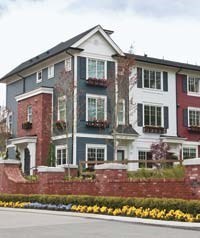
When you think of landscaping, you probably don’t think of a swanky Hoboken co-op, condo or HOA building. After all, landscaping in the usual sense is typically reserved for suburban homes where there is rolling turf, strategically placed trees, sprawling flower beds and maybe even a gazebo or fountain. There's no doubt that greenery and other design elements add to a home’s curb appeal—and in a slowly-improving economy, curb appeal increases value and attracts buyers.
But take a closer look at the outside of that same co-op, condo or HOA building and you’ll see that exterior landscaping is actually a part of the building’s look. Whether it’s curbside planters, historic shutters that complement the building’s veneer or dramatic lighting that draws attention to a unique aspect of the property, there are ways to landscape the exterior buildings that draw its attention to passersby.
“The benefit is definitely curb appeal,” says Howard K. Freilich, CEO of Blondie’s Treehouse, an interior landscaping firm based in New York City that serves the tri-state area. “It makes a good impression and increases the value of the building. If the exterior and the plants look good, people will know that the building is taken care of and will want to live there.”
Planning a Picturesque Exterior
With any spring project, sprucing up the building’s exterior starts with planning. “We meet with the client, look at the existing landscape and see how we can make it work better,” says Freilich. “That determines the selection of the plants, the decorative elements, lighting, irrigation, masonry and more.”
Freilich works with a board or committee to determine the look of the exterior. “Then the committee picks the design they like, based upon our recommendations and their budget. Once it’s approved, we design, install and maintain it. If it’s an existing client, we might refurbish a project by removing some elements, pruning trees back because they have outgrown their space, and so forth.”
“When planning a project, we look at things like lifestyle—whether the people using the space have children or pets or allergies,” adds Asia Wyszatycki, a landscape designer with Landscape Works Inc. in Hawthorne. “Then we do a site visit and take into consideration not only topography or what the existing conditions are, but also sun exposure, because that has a dramatic effect on what we can plant and what will thrive. Soil conditions are also very important, we do soil samples. For example if the property is on rock you don’t want to plant something in that area that’s not hospitable.”
Alan Tanksely, a New York City–based interior designer who has worked in Princeton, suggests that clients try to envision the final effect they're shooting for, and keep that firmly in mind. “With many buildings, you don’t know where the entrance is, so you want to picture it, and create a destination—hit them over the head and create drama,” he says.
Follow the Rules
Planning your picturesque exterior and dramatic entrance might come with some limitations, however, depending on the history and design of your building.
“Physically, the possibilities are limited in terms of how much room you have—and co-ops also have specific covenants and rules as to what can and can’t be done to them,” says Margie Ruddick, a landscape designer based in Philadelphia, who redesigned Trenton Capital Park.
There are rules and regulations from the New Jersey Division of Consumer Affairs that govern landscaping and re-vegetation activities.
According to the official website for the state of New Jersey, landscape permits are required as a prerequisite to any substantial landscaping activities. These can be required only when a construction permit or other municipal approval is required or can be independently required even if no other municipal permit or approval is required. In addition, Consumer Affairs encourages landscape architects to conserve water in the following ways: using non-potable (for example, retained storm water) for irrigation purposes; using moisture sensing devices to regulate automatic irrigation systems; and using manually-operated irrigation systems and the use of drip irrigation systems. For additional information go to www.state.nj.us.
“Often the condominium associations themselves will have guidelines that you have to conform to,” says Wyszatycki. “They will usually say something along the lines of ‘we don’t want that type of plant’ or ‘we don’t want to do that.’ ”
Know What to Plant
No matter what you plant, “Take careful consideration of the environment and choose plants that are perfectly suited to the town’s restrictions,” says landscape architect Tom Balsley, based in New York but whose clients include The New Jersey Department of Parks and Recreation and the New Jersey Institute of Technology.
The state has created a list of preferred types of grasses that are tolerant of droughty, nutrient-poor conditions. Appropriate types include: fescue species, smooth brome grass, reed canary grass, little bluestem, deer tongue, red top and switch grass.
“Everyone loves these wonderful perennial gardens with seasonal color but there is a lot of work involved,” says Wyszatycki. “It’s important to maintain these projects and this should be taken into account when budgeting.”
To maintain current plantings, Freilich says that his company uses native predator insects. “Rather than spraying chemicals, we use organic and natural fertilizers and use good insects that eat the bad ones,” he says. “We also make sure to select the right plants for the right atmosphere and choose the proper pH soil and give it the right nutrients to ensure the plant’s success.”
There are numerous places across New Jersey to buy plants, trees and shrubs. “If it’s a small project, you can find seasonal flowers in large box stores like Home Depot and Wal-Mart,” says Wyszatycki. “My recommendation would be to go to a local nursery. They have all the plant material and they’ll carry things that are known to thrive in our area. Very often the staff are usually very knowledgeable and they’d help you style on your own. And sometimes if it doesn’t work out you can bring it back.”
Other Features
Tanksely suggests lighting as an emphatic and affordable way to change and illuminate an exterior. “It’s usually the least expensive and has the biggest impact without having to change the architecture,” he says. “If the building does have planters, lighting it can also be very effective to break up the urbaneness of the city and make for a more appealing building.”
However, he suggests thinking in ‘layers.’ “The building should have some depth, so surrounding the entrance with planters gives you some depth and then a permanent awning provides a transition from public to private,” he says. “Consider using texture too, a lot of things can be done with natural materials that are elegant and urbane.”
Most importantly, when planning, Tanksely says to look above the first floor. “When you step back you want to look over the whole building, not just one level.”
Think Outside the (Flower) Box
When planning an attractive exterior Balsley suggests thinking out-of-the-box and utilizing existing open space to create Privately-Owned Public Space, or POPS. “They’ve created small little parks or plazas at building entrances or beside them. Some are garden-like and some are plaza-like and they are public open spaces, but they are privately owned.”
Balsley says that sprucing up a building exterior, especially adding greenery, is about more than just picking a type of tree, shrub or flower. “We take any outdoor space and look at it holistically, which means not just beautifying or making it pretty but talking about the goals that the building might have in mind,” he says. “They may be looking for a sustainable landscape, and we help educate them on ways in which their landscape can participate in the green movement. We don’t just look at it as a physical amenity but think about the cross-section of people who may be using the space and building and how. Our intent is to add value, not only to their investment but also to the quality of their lives.”
For a building looking to spruce up their frontage, Wyszatycki recommends starting with plants such as boxwood or holly that offer year-round structure. “What that means is year-round, you‘ll have this structure of greenery that can provide closure for spaces, enhance color or even direct traffic,” she says, “And they are very easily-trimmed and maintained.”
Lisa Iannucci is a freelance writer and a frequent contributor to The New Jersey Cooperator. Staff Writer Christy Smith-Sloman contributed to this article.






Leave a Comment